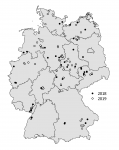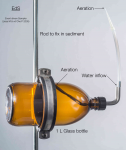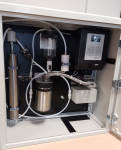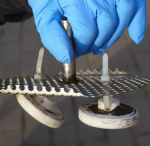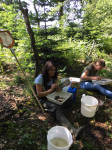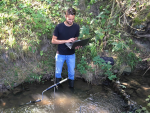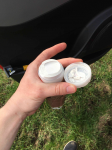Methods
The KgM project comprises a broad spectrum of methods concerning the sampling and the analytics of plant protection products and additional stressors, the quantification of effects on microorganisms and invertebrates, and the modelling of exposure pathways.
A total of 124 stream sections distributed throughout Germany were investigated in 2018 and 2019 (see map below). Criteria for the selection of these streams were
- a small catchment area (usually < 30 km2)
- a gradient in the intensity of agricultural use of the catchment with a focus on predominantly agricultural sites
- as little urban influence as possible
- exclusion of point sources (e.g. wastewater treatment plants)
Representativity of the site selection
The monitoring sites classified as agricultural (> 20 % agricultural land in the catchment) were characterised by a mean share of 76 % agricultural land cover. An analysis of small, agricultural catchments all over Germany (catchment size < 30 km2) showed an average of 66 % agricultural land cover (see distribution curve above). The stream sections investigated in the small water body monitoring thus featured a slightly above-average proportion of agriculturally used land.However, this does not impact the observed pollution status: When extrapolating the investigated monitoring sites to the average agricultural area in Germany, an equally large proportion of monitoring sites with exceedances of the regulatory pesticide thresholds could be expected as was found on the basis of all investigated monitoring sites. This result, which is surprising at first sight, is due to the similar risk of exceedance of sites with a medium and high proportion of agricultural catchment areas. (for details see Supporting Informations of Weisner et al. 2021).
We capture short-term events of peak exposure after heavy rain falls using event-driven samplers. In addition to simple bottle samplers, for the first time we apply novel automatic samplers which report a rising water level, actively collect and cool the water sample.
Additionally, we capture the time-weighted average exposure using ChemCatcher®passive samplers. Finally, we collect and analyse freshwater shrimps as living passive samplers.
The following list gives an overview of all pesticides and metabolites investigated.
The corresponding RAC values can be downloaded:
- Wick A, Scharmüller A, Foit K, Maaßen S, Bänsch-Baltruschat B, Lischeid G, Liess M, Schäfer RB, Keller M (2018): Umsetzung des Nationalen Aktionsplans zur nachhaltigen Anwendung von Pestiziden Teil 2 – Konzeption eines repräsentativen Monitorings zur Belastung von Kleingewässern in der Agrar-landschaft, Umweltbundesamt, Dessau-Roßlau.
Target-Analysis
The target analysis of different substance groups is carried out depending on the substance properties or the distribution between water and suspended particulate material. The polar or hydrophilic substances are detected by direct injection of the water samples obtained using the LC-HRMS system (Department Effect-Oriented Analysis) and by LC-MS/MS with MRM detection (Department of Analytical Chemistry).
The hydrophobic substances, which presumably have only low freely dissolved concentrations, are analyzed in the extracts of the suspended particulate material. Pyrethroids are measured in the extracts after conversion of an extract aliquot into ethyl acetate by GC-MS/MS and Negative Chemical Ionization (NCI). The methods developed should, if possible, achieve sufficiently low limits of quantification to be able to check compliance with the active substance-related quality standards (RAK values, JD-UQN and ZHK-UQN).
Non-Target Analysis
The target analysis of the selected PSM active ingredients described above is supplemented by a non-target analysis. Thousands of chemicals from different anthropogenic, but also natural sources are introduced into surface waters, so that aquatic ecosystems are exposed to complex substance mixtures that vary in time and space. Only a fraction of these substance mixtures is often detected and quantified within the framework of target analysis. Non-target analysis approaches, however, allow for simultaneous recording of a large part of this complex substance mixture (Krauss et al., 2010). The objectives of non-target analysis of water samples using LC-HRMS are to identify typical load patterns for runoff events and to identify previously unknown substances in these events. The results can be used to prioritize chemicals that go beyond the PSM spectrum of target analysis and that can be proposed for inclusion in future monitoring programs if their relevance increases.
Passivsammler
In addition to the event-based sampling and analysis described above, passive samplers are applied and analyzed at all measuring points (Department of Ecological Chemistry, Department of Analytics). The polar PPP active substances are recorded by Chemcatchers, whereby the quantities of PPP accumulated in Chemchatchers can be converted to averaged water concentrations with the aid of published sampling rates (Münze et al. 2015, Moschet et al. 2015) and to peak concentrations in comparison with the event samples. Missing calibration data are to be determined on the basis of a literature search or in laboratory tests. Sorb-stars are used for non-polar PPP active substances (pyrethroids and organophosphates). The Sorb-Star also requires the determination of distribution coefficients of silicon-water in laboratory experiments.
- Kraus UR, Theobald N, Gunold R, Paschke A (2015): Prüfung und Validierung der Einsatzmöglich¬keiten neuartiger Passivsammler für die Überwachung prioritärer Schadstoffe unter der WRRL, der MSRL und im Rahmen von HELCOM und OSPAR. Texte 25/2015, Umweltbundesamt (Hrsg.), Dessau-Roßlau, ISSN 1862-4804.
- Moschet C, Vermeirssen ELM, Singer H, Stamm C, Hollender J (2015): Evaluation of in-situ calibration of Chemcatcher passive samplers for 322 micropollutants in agricultural and urban effected rivers. Water Research 71, 306-317.
- Münze R, Orlinskiy P, Gunold R, Paschke A, Kaske O, Beketov MA, Hundt M, Bauer C, Schüürmann G, Möder, M and Liess, M (2015): Pesticide impact on aquatic invertebrates identified with Chemcatcher® passive samplers and the SPEARpesticides index. Science of The Total Environment 537, 69-80.
The measuring of indiviual compounds with analytical techniques requires a preselection of substances to be analyzed. This way not all relevant organic toxicants may be captured from a stream. Therefore we additionally apply effect-based tests to identify the entire exposure to organic toxicants.
Using an SPE- or LVSPE extraction first we isolate all organic toxicants from a sample and resuspend them in test solutions. Subsequently, we measure acute effects of these solutions using in vivo toxicity tests on algae, daphnids and fishes. When repeating the tests after fractionation of the isolated toxicants, the relevant compounds can identified (Effect Directed Analysis). Additionally, we apply in vitro tests with reporter genes as proxy for chronic effects to study the environmentally relevant modes of action.
We investigate effects on the freshwater community at various levels of biological organization.
The SPEARpesticides bioindicator quantifies the proportion of vulnerable invertebrate taxa and thus indicates pesticide-driven changes in the community composition. We also investigate the composition of the epiphyton and decomposer community.
With AFLP markers we study the effects of pesticides on the genetic diversity of freshwater shrimps. Additionally, we compare the performance and stress tolerance of freshwater shrimps from polluted and non-polluted sites. Finally, we investigate effects of pesticides on the leave litter degradation.
In addition to pesticides we investigate various abiotic environmental factors, e. g. to differentiate between effects from pesticides and from hydraulic stress after heavy rainfall.
Physicochemical parameters such as temperature, conductivity and oxygen are monitored for several weeks using data loggers with minute-by-minute precision. The average stream velocity is monitored through leaching from gypsum cartridges. Additionally we test grap samples for heavy metals.
Text will be added in the near future.

